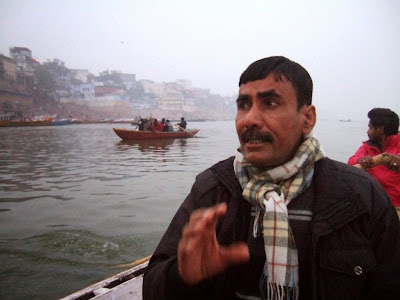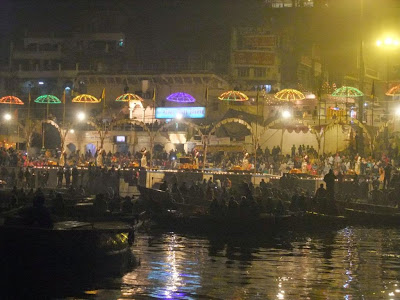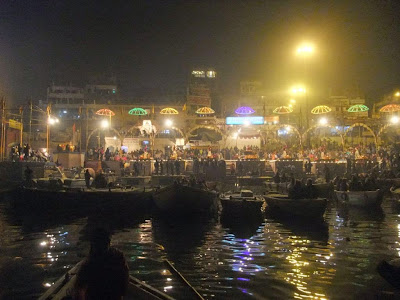
Varanasi, also known as Benares or Kashi, was most probably one of the oldest living cities in the world. It lies on the left bank of Ganges River in the southern part of Uttar Pradesh State in India. Varanasi is a site of spiritual Luminance. Hindu believes that it was the spot where Lord Shiva and his consort Parvati stood when world time started ticking for the first time. Being a city of Shiva and with connection with most legendary figures and mythical characters, the place for ages was a famous destination for Hindus pilgrims. This spiritual, cultural and religious capital of India, said to be founded more than 3000 years ago had a history as old as the civilization of its country.


Hindu regards Ganges River as Amrita, the elixir of life that brings purity to living and salvation to dead. They believe that the holy river has the power to wash away the sins of mortals and people who die on its banks would be free from the cycle of death and rebirth. Every devout Hindu hopes to visit Varanasi once in his lifetime as town or city on the bank of this sacred river is considered as holy and auspicious.


With banks of its ancient ghats, array of shrines, palaces at water edges, myriad temple spires, Varanasi is a city of temples that offers its visitors an unique and mysterious experience.



The Ghats at Varanasi stretching along the whole of the water front at the bank of Ganges River with lines of endless chain of stone steps are jazzed up with 18th-19th century built terraces, temples, palaces and pavilions. It gives out extraordinary sight of scenes fluctuated with river level in different seasons.


Ghats are places with steps leading down to the water. There are nearly 100 ghats bordering Ganges River in Varanasi. Among the 25 main groups that are extending from north to south, from Raj Ghat to Assi Ghat, eight are with significance in history and architecture.


Dasaswamedh Ghat located at the bank of Ganges River near the old Shri Kashi Vishwanath Golden Temple, and where the famous Ganga Aarti takes place every evening, was one of the oldest and most spectacular and significant ghats in Varanasi. The ghat was so called as Dasaswamedh which literally means sacrifice of ten horses as the legend said that ten horses which had been allowed to run free for a year were sacrificed by Lord Brahma in order to let Lord Shiva return after a period of banishment. Another version of its mythological story was that Dasaswamedh Ghat was created by Lord Brahma to welcome Lord Shiva. The incidents are believed to happen in 2nd century.


Dasaswamedh Ghat according to its record, was restored in year 1740 by King Bajirao Pesava and renovated by Indore Queen in 1774.



The boatman getting ready at the dock of Dasaswamedh Ghat to fetch the guests for a boat ride and watch the fire offering ceremony from the river.



Varanasi's Ganga Aarti fire offering ceremony is held at the main waterfront of Dasaswamedh Ghat every day after sun set. People flocked in as early as 5pm in order to get a good position to share the moment.


Gathering here at Dasaswamedh Ghat are Hindu devotees, pilgrims as well as tourists. They came here for the blessing as well as sharing and enjoying the heritage of this ancient religious activity. Some visitors even hired balconies from those shops in the vicinity to have a clear view of it.



Most of the Varanasi Ghats were built after 1700s and meant for bathing and Puja (offering). Each of the hundred ghats in the religious city of Varanai, in regardless of sizes, has its own mythological legend and is marked by a "Lingam" and occupied its old palace or temple. Ahilyabai Ghat was named after Indore Queen of Malwa Kingdom, Ahilyabai Holkar (1767-1795). She was a great donor to Indian religious site. She donated 22x40 kg of gold for Viswanath Golden Temple at Dasaswamedh Ghat and had contributed more than twenty temples and ghats across the country.


Munshi Ghat was constructed in 1912 by the Finance Minister of Indian Darbhanga State.


Our local guide was teaching us how to make flowers and lights offering to Ganges River and all deities. We can make wishes while set the flower or lighted candle adrift on water. I wished the world is always in peace and every one has no fear and danger whenever they go.


Strolling on Ganges River on a boat ride to view its historical Ghats lined up at the banks adorned with ancient temples and palaces.



A colorful riverfront of Varanasi at night.


The ceremony of Ganga Aarti begins with blowing of a conch shell, followed by waving of odd numbered incense sticks in elaborate patterns. The priests then hold tight a flaming lamp and move them in circle synchronizing to the rhythmic charts of hymns and clang of cymbals. The lighted lamps and flowers after offering were sprinkled and circulated over devotees.


Ganga Aarti is kind of Ani Pooja, The fire worship ceremony performed on a stage by a group of young pundits wrapped in saffron colored robes. Spread out in front of them are Plates of Puja. The offering dedication are made to Hindu God Lord Shiva, Ganges River, The sun Surya Agin as well as the whole universe.




The interesting Ganga Aarti ceremony that held every evening after sunset in the holy city of Varanasi attracts thousands of pilgrims to gathering at the main ghat of Dasaswamedh and receive the blessing when fire is offered to River Ganges.


Aarti is a Hindu ritual of worship performed during most of Hindu ceremonies or occasions. It is part of their Puja (Offering) but sometimes it also refers to songs that sung to praise the deities when making offering.



The whole Puja ritual was performed by group of priests at the stage built along the main Dasaswamedh Ghat. The lamp wicks was soaked in ghee and lighted up to make offerings.




Huge crowd are attracted from every corner of the city.



It was a great experience to see the real attraction of Ghats in the evening when Ganga Aarti was held.



We are like many others chose to watch the interesting Ganga Aarti ceremony at Dasaswamedh Ghat directly from boat.


While the thick scent of sandalwood began to permeate into the air, the darkened sky was brighten up by the flaming hue of the lamps.


The water front is full of boats with guests as this is the best way to capture a panoramic view of the ceremony.



People staying in the boat in the dark immersed in the cultural atmosphere of this religious activity and at the same time waiting to see the divine look of Ganges River when thousands of earthen lamps are immersed in its waters and floating on it.


Varanasi ghats has long been a religious spot for Hindu devotees and pilgrims.


Varanasi is also a notable center for Moksha (nirvana). The burning ghat Manikarmika located just short distance away from the main Dasaswanedg Ghat, is most confronting as people come face to face with death. This was the place in Varanasi where majority of dead bodies were cremated. The shore that lined up with piles of firewood, and with fire flaming into air, never ceased in receiving dead bodies wrapped up in a cloth and carried in through a lane on a man-shift stretches. Hindu believes that passing away and having open cremation at the bank of holy Ganges River is an assurance of heavenly bliss and free from the suffering in the cycle of death and rebirth.


Although majority of cremation was done in Manikarmika Ghat, Harishchandra Ghat is the site where Hindu custom cremation took place. It was the place where owner of Manikarmika caught King Harishchandra and brought him here to make him work as a slave.


Riding on The Ganges River!


We are ready to have our boat ride on the world holy river.


The vast and mysterious Ganges River.




Boats are part of the scenic sight to Veranasi Ghats







The bustling town of Hindu most holiest city, Varansi.


Banarasi silk sarees and brocades produced from Varanasi are most famous and pricey over the world.



nice post
ReplyDelete